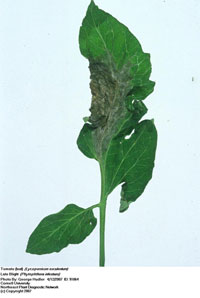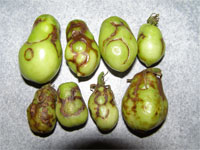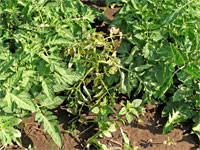Extension > Garden > Diagnose a problem > What's wrong with my plant? > Vegetable > Tomato > Discolored fruit
Tomato > Fruit > Discolored fruit
1 of 4
Cold injury
- Leaves look water-soaked and soft, then turn black
- Fruit becomes soft water-soaked and rots
- Leaves show injury immediately, fruit may not show symptoms for 5 to 7 days
- Occurs at temperatures below 50° F
2 of 4
Sunscald
Abiotic
- Affects fruit, young leaves and stems
- Occurs only on tissue exposed to the sun
- Fruit turns tan or white on exposed side, may dry out and appear wrinkled
- Young leaves of transplants turn grey with irregular bands on the lower side
- Young stems of transplants turn white on exposed side only
- More information on Sunscald
3 of 4
Late Blight
Phytophthora infestans
- Irregular water-soaked lesions on leaves, turn olive then brown
- Leaves, stems and petioles turn brown and shrivel
- Fruit spot is round olive colored, can cover whole fruit
- Infected tissue is covered with white mycelia is wet weather
- Disease spreads very rapidly in cool wet weather
- More information on managing plant diseases in the home garden
4 of 4
Virus
Cucumber mosaic virus, tomato mosaic virus, tomato
spotted wilt virus and more
- Leaves are mottled with yellow and light green patches
- Leaves are misshapen; unusually long and thin like a shoestring or curled and deformed
- Fruit have yellow blotches or brown rings
- Plants are stunted even when neighboring plants look healthy and tall
- More information on Virus











